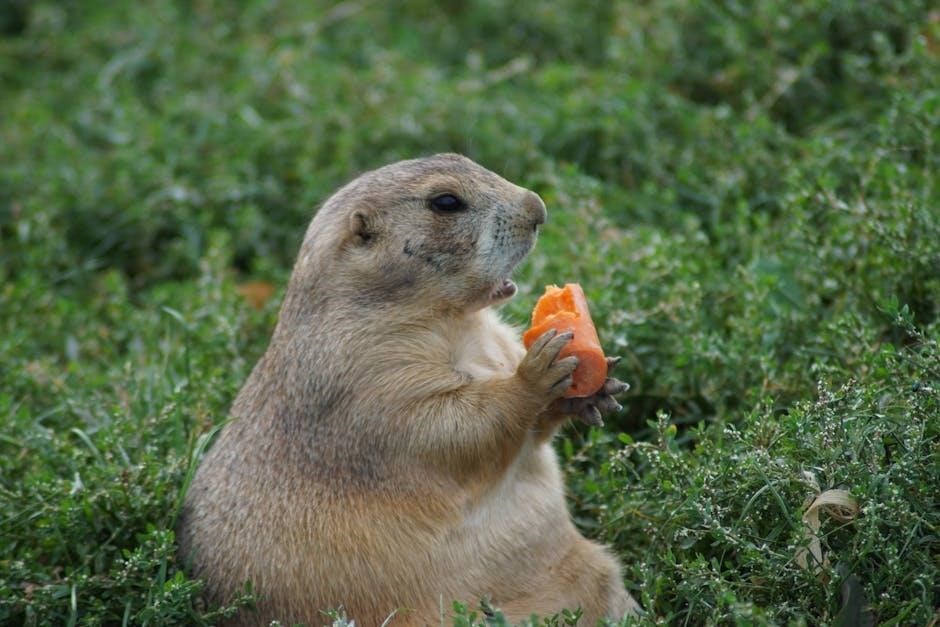Foraging involves searching for wild foods, using online resources and
guides
to identify edible plants and fungi, and understanding regional environments and climates to ensure a successful foraging experience always.
Definition and Importance of Foraging
Foraging is defined as the act of searching for and gathering wild foods, such as plants, fungi, and other edible resources, in their natural environments. This practice has been essential for human survival throughout history, providing a means of obtaining nutritious food and promoting self-sufficiency. The importance of foraging lies in its ability to reconnect individuals with nature, fostering a deeper appreciation for the environment and the food we eat. By adopting foraging as a way of life, individuals can reduce their reliance on industrial agriculture, promote sustainability, and cultivate a healthier relationship with the natural world. Foraging also offers numerous physical and mental health benefits, including increased physical activity, reduced stress, and improved cognitive function. Additionally, foraging can be a fun and rewarding hobby, allowing individuals to explore new environments, learn about wild foods, and develop a sense of community with like-minded individuals. Overall, foraging is a valuable practice that offers numerous benefits for individuals and the environment.
Types of Wild Foods
Various wild foods include fruits, nuts, and berries, found in forests and woodland areas always.
Edible Plants and Fungi
Edible plants and fungi can be found in various environments, including forests, fields, and coastal areas, with many species having unique characteristics and uses.
Some plants, such as wild garlic and chicory, are commonly used in salads and as flavorings, while others, like dandelion and burdock, have medicinal properties.
Fungi, including mushrooms and truffles, are prized for their culinary value and can be used in a range of dishes, from soups to sauces.
Online resources and field guides can help foragers identify edible plants and fungi, and understand how to harvest and prepare them safely.
Many species of edible plants and fungi are seasonal, and foragers must be aware of the best times to harvest them to ensure optimal flavor and nutritional value.
By learning about edible plants and fungi, foragers can expand their knowledge and enjoy a wider range of wild foods.

Foraging Techniques and Safety
Foragers use various techniques and follow safety guidelines to ensure successful foraging experiences always using proper equipment and tools.
Identifying and Harvesting Wild Foods
Identifying and harvesting wild foods is a crucial aspect of foraging, requiring a deep understanding of the natural environment and the characteristics of edible plants and fungi. Foragers must be able to distinguish between safe and toxic species, using field guides and expert knowledge to inform their decisions. The harvesting process itself also requires care and attention, as over-foraging can damage ecosystems and threaten the long-term sustainability of wild food sources. By adopting responsible and sustainable harvesting practices, foragers can help to preserve the natural balance of their environments while also enjoying the many benefits of wild foods. Online resources and communities can provide valuable support and guidance for foragers, offering tips and advice on identification, harvesting, and preparation techniques. With experience and practice, foragers can develop the skills and confidence needed to safely and successfully identify and harvest wild foods.
Regional Foraging Guides
Regional guides provide essential information on wild foods, including
maps and species lists, to help foragers navigate different environments and climates successfully always.
Foraging in Different Environments and Climates
Foraging in various environments and climates requires a deep understanding of the local ecosystem and the species that inhabit it. Foragers must be able to identify the unique characteristics of different regions, including the types of plants and animals that are found there. This knowledge can be gained through experience, research, and guidance from experienced foragers. By understanding the different environments and climates, foragers can increase their chances of finding wild foods and minimize the risk of encountering harmful species. Different environments, such as forests, grasslands, and coastal areas, support a wide range of wild foods, and foragers must be able to adapt to these different environments to be successful. Additionally, foragers must be aware of the impact of climate on the availability of wild foods and plan their foraging trips accordingly.

Foraging Communities and Resources
Online forums and social media groups connect foragers, sharing knowledge and resources about wild foods and foraging techniques always and everywhere easily.
Online Forums, Books, and Expert Guides
Foragers can access various online forums, social media groups, and websites dedicated to wild food foraging, where they can share knowledge, ask questions, and learn from experienced foragers. Many books and field guides are also available, written by expert foragers and botanists, providing detailed information on plant identification, edible species, and safe foraging practices. Additionally, expert guides and instructors offer workshops, classes, and guided foraging tours, teaching beginners and experienced foragers alike about the art of wild food foraging. These resources provide a wealth of information and support, helping foragers to develop their skills and confidence in finding and preparing wild foods. By utilizing these resources, foragers can ensure a safe and enjoyable foraging experience, while also contributing to the growth and development of the foraging community. Online platforms and expert guides play a crucial role in promoting sustainable foraging practices.
and Future of Foraging
Foraging continues to evolve with online resources and expert guides supporting its growth and development always successfully.
Sustainable Foraging Practices and Conservation
Foragers must adopt sustainable practices to conserve wild food sources, using online resources and expert guides to inform their methods.
Regional environments and climates play a crucial role in determining the best approaches to sustainable foraging, and foragers must be aware of these factors to ensure the long-term health of the ecosystems they harvest from.
By taking a responsible and conservation-minded approach to foraging, individuals can help preserve the natural world while also enjoying the many benefits of wild foods, and online communities and forums can provide valuable support and guidance in this pursuit, always.